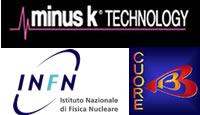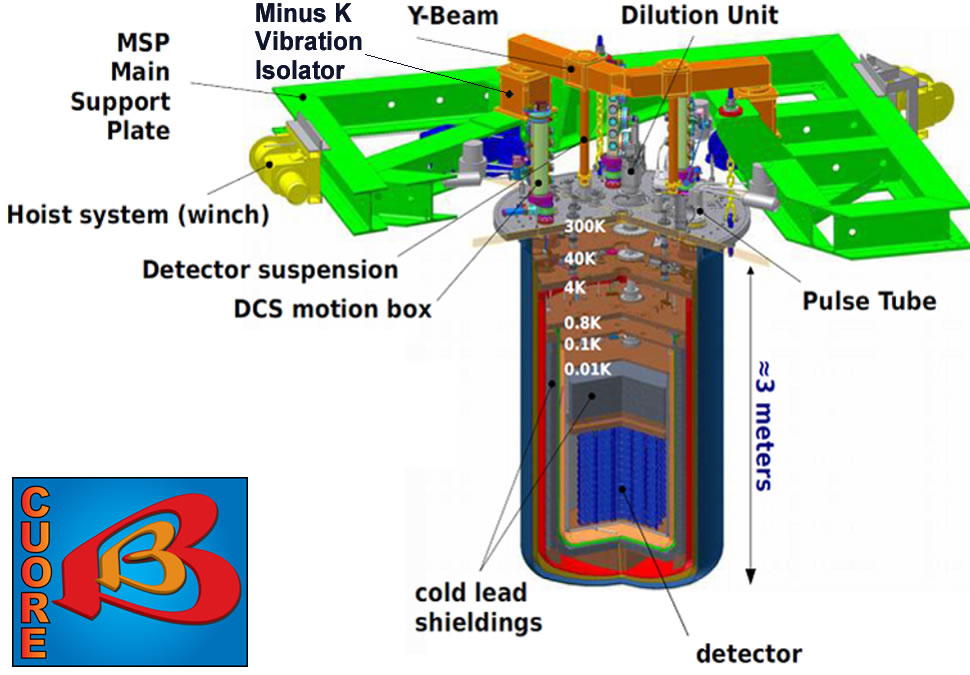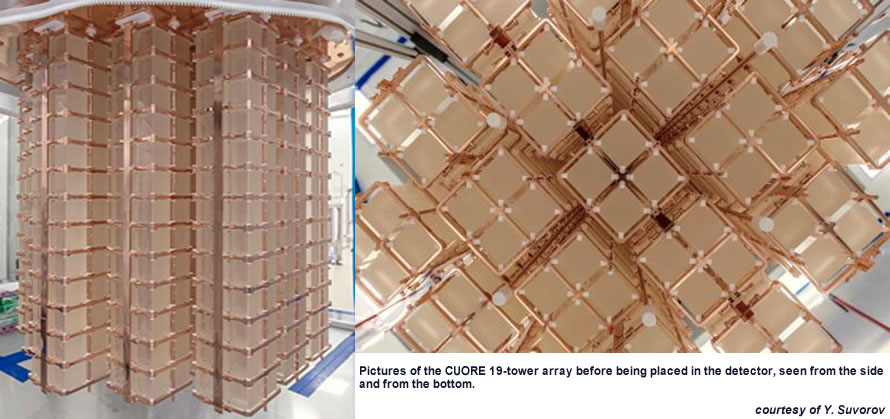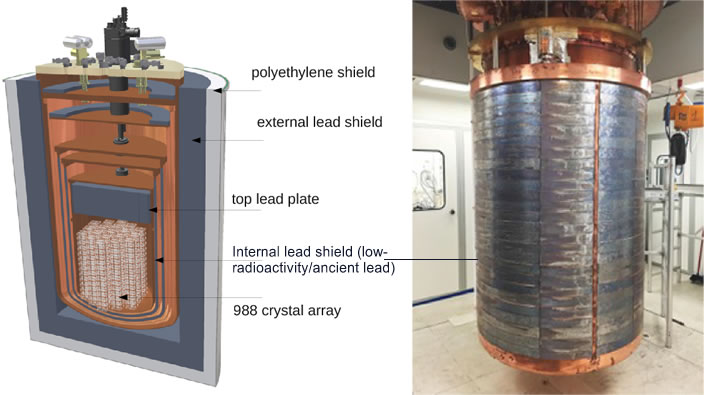
Minus K Technology & CUORE INFN - October 2017
Sunken Treasure Surrounding The Coldest Cubic Meter In The Universe Is Supported By Minus K Vibration Isolators
As of January 2017 the CUORE detector has reached its operating at a base temperature of 10 mK! This is over one ton of tellurium dioxide and copper cooled to a hundredth of a degree above absolute zero. Making it the single coldest cubic meter in the universe.
The Cryogenic Underground Observatory for Rare Events (CUORE) is a 1-ton scale bolometric experiment that will examine a property of ghostly neutrinos by looking for a phenomenon called neutrinoless double beta decay. Revealing this process could be a clue as to why there is more matter than antimatter in the universe and show that neutrinos get their mass in a way that’s different from all other particles.
Unlike ordinary beta decays, in which electrons and antineutrinos share energy, the neutrinoless double beta decay produces two electrons, but no neutrinos at all. It is as if the two antineutrinos that should have been produced annihilate one another inside the nucleus.
The cryostat consists of six nested vessels and shields. The three outermost ones are included in the outer Cryostat. Two of them (300 K and 4 K) are vacuum tight: the space between the 300 K and 4 K vessels constitutes the Outer Vacuum Chamber (OVC) of the cryostat and the 300 K vessel operates at room temperature. The volume inside the 4 K vessel represents the Inner Vacuum Chamber (IVC) and in normal running condition this vessel is thermalized to 4 K. Between the 300 K and 4 K vessel there is a thermal radiation shield at 40 K covered with a multi- layer aluminized superinsulation
The entire cryostat is suspended from a heavy steel support structure, Main Support Plate (MSP) which bears the load of close to 20 tons, specifically the detector (~1 ton), thermal shields and flanges (~8 tons) and the internal lead shielding (~10 tons).

The detector suspension has been designed to minimize the transmission of mechanical vibrations both due to seismic noise and to the operation of cryocoolers and pumps. The suspension is a two stage low-frequency isolator fixed to a Y-beam above the cryostat, in the vertical direction, and a pendulum with a natural frequency of about 0.4Hz, in the horizontal direction. It must provide load path for the detector while minimizing the heat input and the vibration transmission.
The suspension is made up of three Minus K Negative-Stiffness vibration isolators and the Y-beam positioned on top of them which is mounted on top of the Main Support Plate (MSP). The detector is suspended by the Y-beam through three composite rods. The system formed by the Minus K isolators and the rest of the detector will behave like a spring-mass system with a cut-off frequency of 0.5Hz. The composite rods are be made of several 316LN stainless steel rods, with three copper thermal links connecting to 40K, 4K and Still plates. Also to minimize vibrational noise of the detector as much as possible there are independent suspensions for the vessels, dilution unit, and detector.
The 0.5 Hz natural frequency Minus K isolators were customized to include snubbers to limit the maximum acceleration load from a severe earthquake to an acceptable level for the detector, says Dr. David Platus, President of Minus K Technology. “We simulated a 0.6 g earthquake (multiple times) to ensure that when supporting the detector the isolators reduced the force of an earthquake to well below the acceptable limits required by INFN”.
The installation of 19 "towers" that make up the detector was completed near the end of August 2016. "All of the 19 towers that make up the detector, consisting of 988 Tellurium oxide crystals and weighing nearly 750 kg (1650 lbs), are now suspended from the coldest point of the experiment cryostat," said Oliviero Cremonesi, the experiment’s spokesperson.

Avoiding radioactive contamination and shielding the experiment from outside sources that might mimic the telltale energy signature CUORE is searching for is one priority. The mountains at Gran Sasso will provide one layer of shielding from cosmic bombardment, but the CUORE cryostat will also get a second layer of protection against the minor radiation from the mountain itself.
Lead excels at blocking radiation but contains small amounts of a radioactive isotope (lead-210) produced by natural radioactivity which is ubiquitous on the earth. In newly mined metal this isotope (which can't be chemically separated from stable lead) is just beginning to decay. "We could never use it for our experiment, which is exactly about keeping background radioactivity to a minimum," says Ettore Fiorini, a physicist at the University of Milan-Bicocca and spokesperson emeritus of the CUORE experiment.
INFN received 270 Ancient Roman lead ingots, each weighing about 33 kilograms, from a Roman shipwreck that occurred more than 2000 years ago (sank between 80 B.C. and 50 B.C.) off the coast of Sardinia, that have been made into a shield that will cocoon the crystal towers.
The Roman lead is pure, dense and much less radioactive, almost all of the lead-210 has already decayed. The ingots that sat at the bottom of the sea for two millennia have been spared cosmic bombardment and provide very clean, if somewhat exotic, shielding material which is ideal for shielding sensitive experiments that hunt for dark matter and other rare particles.

With the historical significance, many archaeologists objected to melting down the 2,000-year-old Roman ingots. The lead bars from the Bou Ferrer shipwreck were not simply melted down and recast. Rather, considerable precautions were taken to lose as little information as possible.
First, only the most damaged ingots were selected for transfer to INFN (Italian National Institute for Nuclear Physics). All Roman lead bars include stamped characters identifying the smelter, the miner, and often the mine from which the lead came. The material in which these symbols were stamped was removed from the rest of the ingot, and stored for archaeological reference.
270 ingots were given to INFN and a sizeable fraction has been used for the CUORE construction. The lead ingots were cryoblasted to remove all surface contamination. This process, which causes no radioactive contamination, consists of bombarding the surfaces with a pressurized stream of dry ice. The ingots were then melted down to obtain the segments and panels required to assemble a 3-centimetre-thick lead lining shield that surrounds the cubic CUORE detector. This work, which was carried out at the German MTH Metall-Technik Halsbrücke GmbH & Co KG took more than two months.

CUORE is the largest bolometric array ever attempted and the cryostat is the largest ever operated at a temperature of 10 mK. Constructing and commissioning such a large cryostat was a challenge, a challenge intensified by the requirement to use only low-radioactivity materials. The CUORE cryostat was designed to overcome three main challenges: cooling down such a large mass to base temperature of 10 mK, reduction of vibrational noise transmitted to the detectors to ensure a good energy resolution, and background reduction through strict selection of cryostat materials.
CUORE is a collaboration of over 150 scientists mainly from institutions in Italy and the United States. CUORE is supported by the Istituto Nazionale di Fisica Nucleare (INFN), the National Science Foundation (NSF), the Alfred P. Sloan Foundation, the University of Wisconsin Foundation, Yale University, the US Department of Energy (DOE) Office of Science, and the National Energy Research Scientific Computing Center (NERSC).